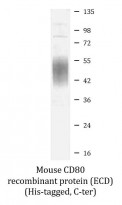ARG70336
Mouse CD80 recombinant protein (His-tagged, C-ter)
Mouse CD80 recombinant protein (His-tagged, C-ter) for Binding Activity,SDS-PAGE and Mouse
Overview
| Product Description | HEK293 expressed, His-tagged (C-ter) Mouse CD80 recombinant protein. |
|---|---|
| Tested Reactivity | Ms |
| Tested Application | Binding, SDS-PAGE |
| Target Name | CD80 |
| Species | Mouse |
| A.A. Sequence | Val38 - Lys245 of Mouse CD80 (NP_033985.3) with 6X His tag at the C - terminus. |
| Expression System | HEK293 |
| Alternate Names | B7.1; CTLA-4 counter-receptor B7.1; CD28LG; T-lymphocyte activation antigen CD80; B7-1; CD28LG1; B7; LAB7; Activation B7-1 antigen; CD antigen CD80; BB1 |
Application Instructions
| Application Note | Binding activity test: Measured by its binding ability in a functional ELISA. Immobilized Recombinant Mouse CD80 at 2 µg/ml (100 µl/well) can bind Recombinant Human CTLA-4 with a linear range of 16-66 ng/ml. |
|---|
Properties
| Form | Powder |
|---|---|
| Purification Note | 0.22 µm filter sterilized. Endotoxin level is <0.1 EU/µg of the protein, as determined by the LAL test. |
| Purity | > 92% (by SDS-PAGE) |
| Buffer | PBS (pH 7.4) |
| Reconstitution | Reconstitute to a concentration of 0.1 - 0.5 mg/ml in sterile distilled water. |
| Storage Instruction | For long term, lyophilized protein should be stored at -20°C or -80°C. After reconstitution, aliquot and store at -20°C for up to one month, at 2-8°C for up to one week. Storage in frost free freezers is not recommended. Avoid repeated freeze/thaw cycles. Suggest spin the vial prior to opening. |
| Note | For laboratory research only, not for drug, diagnostic or other use. |
Bioinformation
| Gene Symbol | CD80 |
|---|---|
| Gene Full Name | CD80 molecule |
| Background | The protein encoded by this gene is a membrane receptor that is activated by the binding of CD28 or CTLA-4. The activated protein induces T-cell proliferation and cytokine production. This protein can act as a receptor for adenovirus subgroup B and may play a role in lupus neuropathy. [provided by RefSeq, Aug 2011] |
| Function | Involved in the costimulatory signal essential for T-lymphocyte activation. T-cell proliferation and cytokine production is induced by the binding of CD28, binding to CTLA-4 has opposite effects and inhibits T-cell activation. (Microbial infection) Acts as a receptor for adenovirus subgroup B. [UniProt] |
| Cellular Localization | Membrane; Single-pass type I membrane protein. [UniProt] |
| Calculated MW | 33 kDa |
Images (1) Click the Picture to Zoom In






